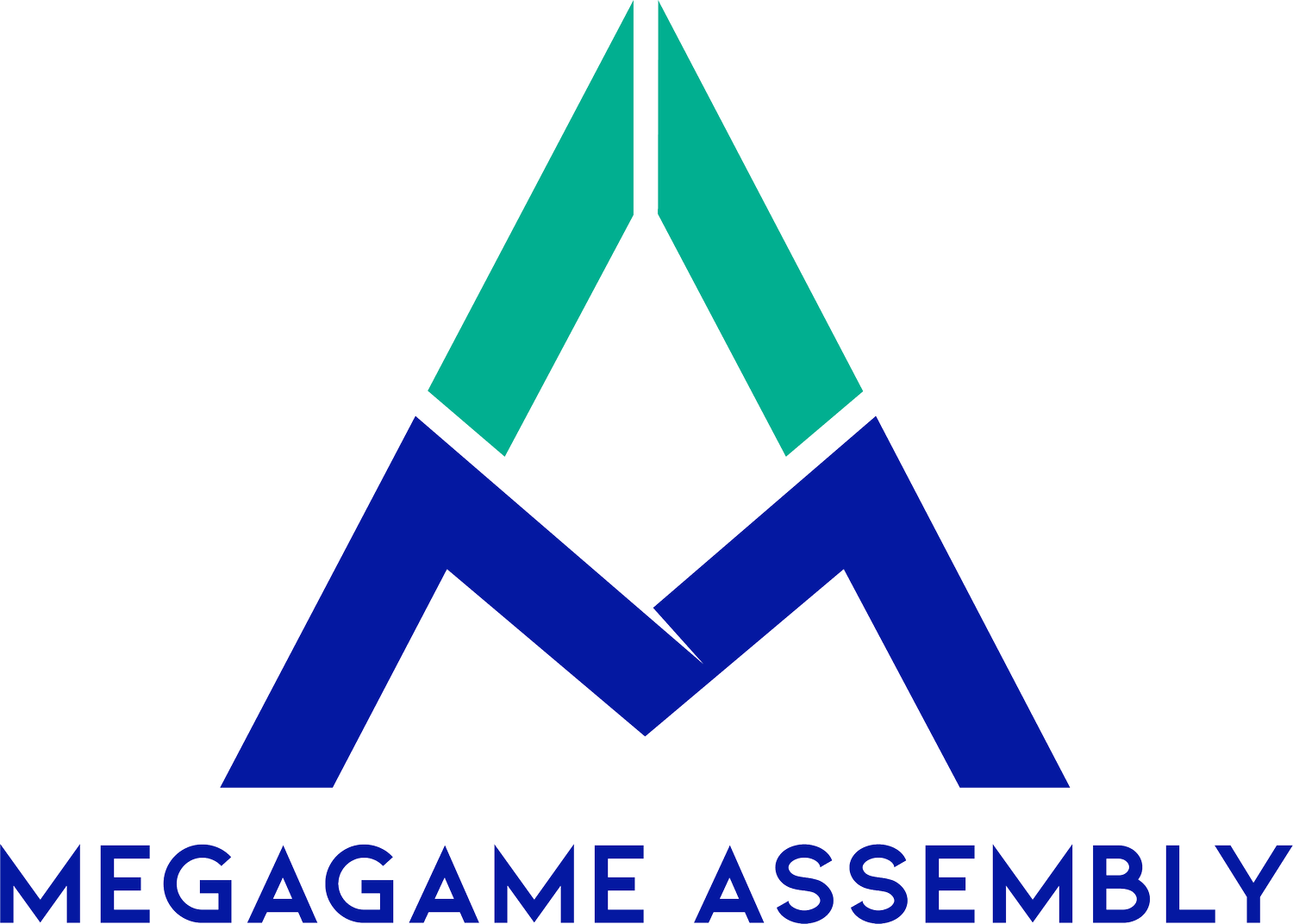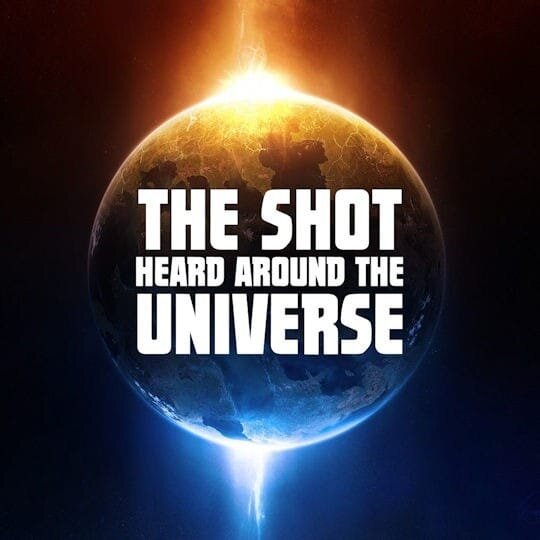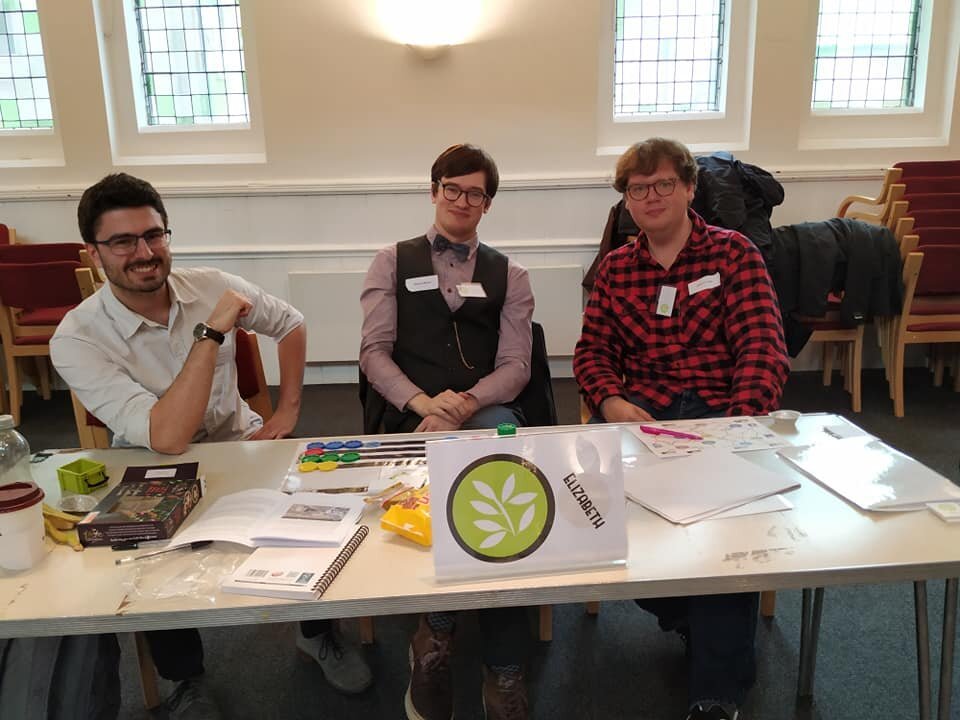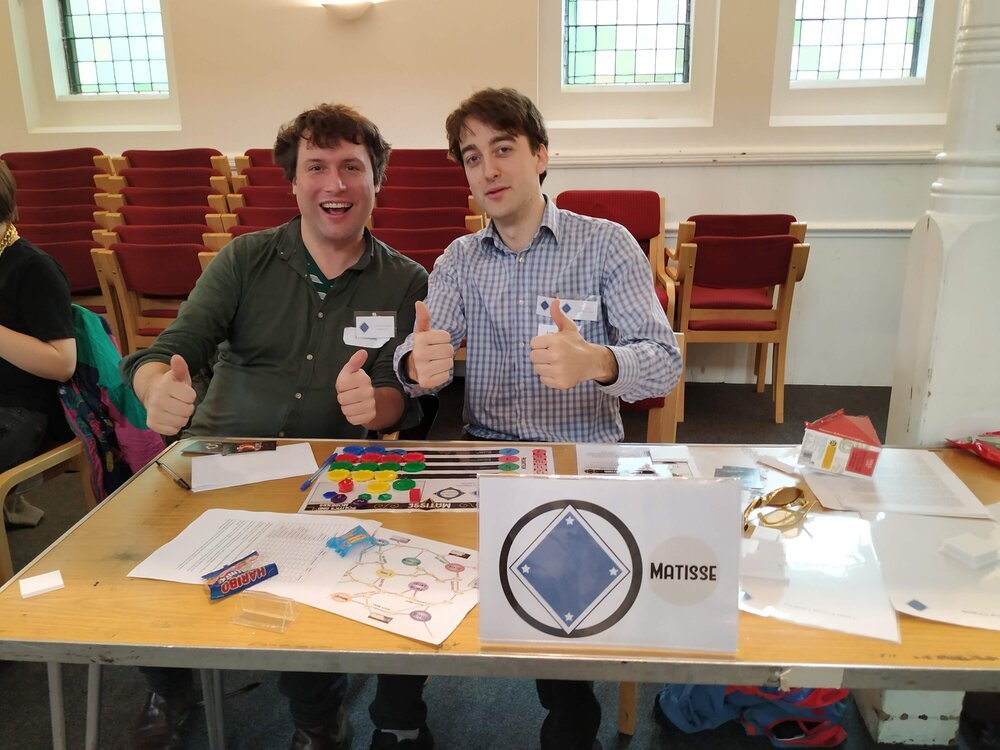The Shot Heard Around The Universe megagame report
Darren Green recently played ‘The Shot Heard Around The Universe’ megagame recently in Reading, UK. Here he gives us his report and how he got on.
The Shot Heard Around The Universe promo shot designed by John Keyworth (Picture by John Keyworth / Reading Megagames)
I only get to book a megagame a week or so before the event these days. Luckily, I can usually find a spot if I’m willing to take whatever roles need filling. So, I was happy to find I was free on the weekend of Reading (UK) Megagames’ re-running of Tim Campbell’s The Shot Heard Around the Universe. I was interested in this game when it was first run. Tim had told me that it was inspired by the background of the Traveller RPG (which I love) and it is also a sci-fi re-telling of the formation of USA from the British colonies during the American Revolution (which I find fascinating).
When I asked organiser, Ed Silverstone what role he would like me to fill he mentioned that he thought the game would benefit from having a team playing the Krill, if I could find one or two more people to make a team. The Krill are described as bird-like, mysterious aliens. It seemed like a team that was light on game mechanics and big on roleplay. My partner, Luisa has played Watch the Skies and has observed my growing involvement in the megagame scene over the past few years and this looked like the perfect opportunity for her to have another go at a game.
The game is set in the Beyond sector. This may be a reference to the works of Jack Vance who sets some of his sci-fi stories in the Beyond (Jack Vance is also one of my favourite writers, so this game was really ticking all the boxes for me). Vance is famous for creating believable, yet quirky societies and each of the worlds of Beyond had their own unique culture very much in Vance’s style. Let’s take a look at them:
Kentai – one of the oldest colonies of Beyond, originally established by an aristocrat from Earth and determined to carve out its own empire in the Beyond sector
Matisse was conquered by Kentai and (possibly in response) the colonists of Matisse have built a world-spanning military organisation.
Helen’s World was founded by academics who sought to build a utopia.
Elizabeth is a garden world and its colonists rapidly divided it up into agricultural estates. They use gene-mods (artificial humans) to plant and harvest their crops. Most of the other colony worlds turn a blind eye to this - they no doubt import food from Elizabeth – but the freedom loving Matissians have objected and invaded Elizabeth in the past in an attempt to put a stop to the practice and free the gene-mods.
Monmouth – a winter world settled by hardy clans but biding their time to repay the Kantai for invading them.
New Angeles was settled by the Imperial Ministry of Colonisation and is a cultural centre of the sector.
Jasmine was settled by a religious cult. The Empire decided they would ‘export’ them to Beyond by offering them a world of their own where they would be less trouble (at least, to the Empire).
Yang 3 is a barren world that was given to the Yang corporation to develop.
A picture of the Beyond Sector map showing the major homeworlds of the different played worlds (Photo by: Darren Green)
So much for the colonies. The largest team in the game (8 people) was the Terran Empire who were nominally in control of the sector. The Sector Governor (assisted by aides from various Imperial Ministries and a several capable fleets) had the job of making the colonies pay their taxes and keeping the peace (ie trying to stop them invading each other).
To round the game out, we also have the Free Beyond rebels who will not rest until Beyond is released from its Imperial shackles and ourselves, the enigmatic Krill. Finally, one should not forget the hardest working roles of the day, the two Press players, one giving the Imperial side of the story and the other the alternative view of Free Beyond.
Ed has posted a much more in depth overview of each of the colonies and other teams on the Reading Megagames webpage. The easiest way to access them is through the discussion tab on the Facebook Event for the game.
Right let’s take a look at how things turned out on the day.
Darren and Luisa as the Krill. What do they want and how will they get on? (Photo by: Darren Green)
So, the Krill. Who were we? Our briefing made clear that we viewed ourselves as superior to humans and that we were sure we had a purpose – we just weren’t sure what it was! Most of the Krill lived on a Dyson sphere (an artificial sphere that encloses a star) that was located in interstellar space and was not known to anyone else. This sphere was known as the Nest and it more or less looked after itself – which is just as well, because the Krill had no idea how to operate most of the machinery on it.
The Nest could open hyperspace jump points to nearby systems which would allow us to visit the worlds of Beyond. The Nest was also home to the Guide. The Guide gave us our instructions. I assume the Guide was some sort of machine intelligence because, like the machinery on the Nest we had trouble interfacing with it and interpreting the messages the Guide gave us. This was represented in the game by our team being given a Rorschach inkblot and some rules as to how we should interpret it.
Unfortunately, navigating the M25 proved more difficult than navigating the hyperspace lanes and we arrived just as turn 1 was getting into swing. We got our costumes on and took a look at the inkblot for the turn. That’s about all we had time to do before the turn was over.
We got another inkblot during team time and there were definite similarities but interpreting these things was a lot harder than I thought it would be. We were sure we had to do something on one side of the map – but was the Guide telling us to attack or explore? Well, there are some people who may enjoy starting a megagame by randomly attacking other players, but we didn’t fancy it (even if we had the perfectly good excuse that some god-like machine intelligence told us to do it). We decided we wanted the chance to meet our human neighbours first before targeting their ships with missiles.
Also, we had farming settlements on Monmouth, New Angeles and Helen’s World and feared they would be massacred if we came across as the heartless death-dealing kind of aliens. Oh, and perhaps more importantly, we only had three really poorly armed ships – obviously the only ones that the Krill could figure out how to operate.
So, we decided the Guide wanted us to explore and set about visiting all the other teams and finding out what our human neighbours were up to. We tried to play on the mystique of the Krill so that the other players wouldn’t guess how weak we were!
The humans were on the whole interested to meet us. They asked us lots of questions, one of the recurring questions was ‘what do you want?’ If only we knew! We said we wanted our farming settlements to be allowed to go about their business and if a world didn’t have a settlement we asked if we could settle there.
This was the pattern for the next couple of turns. Helen’s World were quite concerned about what our settlement was up to but Luisa managed to placate them. We soon had settlements on all worlds apart from Jasmine and Yang 3. Jasmine refused to have any Krill on their world at all and Yang 3 pointed out that it was a barren world so our farming settlement wouldn’t have much to do.
Perhaps the Krill should have offered Jasmine cash to settle on their planet? (Photo by: Darren Green)
We were also contacted by the leader of Free Beyond who revealed that he was in fact a secret non-human agent for the bugs (another alien race found in other sectors and which the Terran Empire is waging war against). This agent was searching for evidence of the Forerunners and asked if we knew of them. We had no knowledge of any Forerunners.
I really liked this move by Ed McDaniel (the leader of Free Beyond). He gave us information that if we had passed it on to the human players would have probably wrecked his entire plan and he relied on us role-playing. It worked. By this point of the game we were deeply in role so there was never any risk of us exposing Ed, but I still wanted some proof that he wasn’t actually human – as he did look very human.
The Free Beyond leader generously provided some DNA and I was assured by control that the Nest had all sort of analytical devices that could process the sample. Of course, when it came down to it we were not able to actually interpret the output of said analytical devices. Was Ed human or not? Picture two Krill poring over holograms of genomes annotated in strange symbols.
It was about now that I began thinking about the origins of the Krill. I had it in my mind that the Krill were a fallen race. They created Nest and all the machines within it, but something caused them to regress technologically. But this mention of Forerunners made me think that maybe the Nest was created by them. Maybe we were some sort of servitor race for the Forerunners? Maybe it was even worse than that – maybe we were their food!
The Imperial team in deep discussion about which planet to tax next (Photo by: Darren Green)
With this worrying thought in mind, we decided that if there were Forerunners around we wanted to know about them, so we decided Ed was indeed non-human and we would share any information about Forerunners with him.
With this worrying thought in mind, we decided that if there were Forerunners around we wanted to know about them, so we decided Ed was indeed non-human and we would share any information about Forerunners with him.
We looked at the drawing (it was a geometric shape) and tried to interpret it according to the rules we had been given. It seemed to suggest that we should continue exploring. This was a bit odd as I had already checked with control and the ships that we had were not capable of surveying uncharted space. However, the humans did have survey ships and had been exploring like crazy.
They had already discovered several worlds fit for colonisation (and we had dutifully asked if we could send some of our settlement ships with the initial colonists). Matisse also told us that they had discovered an abandoned Krill world. Now in retrospect, it seems like we really should have paid a lot more attention to this nugget of information – but it’s a megagame and we had a lot on our collective minds.
For one thing, we had asked control if we could have some Krill gifts we could give out to help with our diplomatic effort. We were given some red cubes and told we could make up our own description of what the gifts were, bearing in mind that they were bits of technology that we probably did not fully understand or had re-purposed to do something that it was not originally designed to do. That got us totally engaged. We gave a high-tech plumage comb to Helen’s World which we hoped would smooth out our difficulties. Then Elizabeth got a cloud generator to create rain or shade and help with their agricultural efforts (actually, one of the more useful gifts).
Now, while all this exploring and gift-giving and settling was going on the rest of the game was happening around us too. There had been piracy and anti-piracy. There had been clashes between space fleets. And, of course there had been invasions. We found our warriors at Helen’s World involved in a stand-off against Imperial troops who were holed up in the starport with no way off world. Free Beyond had been trying to encourage colonies to rise up and rebel and there had been much infighting between Imperial ministers. And, amongst all of this the colonies had been meeting to agree a constitution for their own independent ‘space state’.
The fine gentlemen of Elizabeth farming for victory (Photo by: Darren Green)
To create the constitution players had to agree on a set of cards each of which made a statement about how some element of life in this new state would be governed. All worlds except Jasmine and Yang 3 formed the state of New Beyond with the following cards making up the constitution:
Executive – directly chosen by citizens with each world having an equal number of votes
Legislature – directly chosen by citizens with each citizen having one vote
Judiciary – the Legislature is the highest court of appeal
Amendment – the Legislature may alter the constitution by a simple majority
Taxation – at least 75% of the worlds must agree on any proposed taxes
Military (and Conscription) – worlds raise and command their own fleets but there is a small standing fleet always in operation and the worlds voluntarily provide ships for this.
Law Enforcement – there is no state police force, all law enforcement is carried out by each world’s police force
Foreign Affairs – there is no central office of foreign affairs, each world is at liberty to declare war on or make treaties with other worlds outside of the state
Gene-mods – may be created and used but their products must be clearly labelled and there is a welfare code for them.
Colonisation – all worlds are free to colonise any unoccupied system without requiring approval from the state.
An array of constitution cards from the game (Photo by: Darren Green)
This was one of the most fascinating aspects of the game. I congratulate the teams that worked together to create the constitution and form New Beyond. There are so many considerations that I can imagine that in some games it might be very difficult for so many teams to agree on all these details – especially when each card can affect the governments of certain worlds positively or negatively, so this is not just an exercise in political philosophy.
We tried to congratulate the new executive (he called himself the President) of this freshly created state, but he seemed a little bit busy – the Terran Empire had decided to crush this upstart state.
Meanwhile, things were going well for the Krill team. We had instructed all our settlements to raise shrines to the Source and let the worlds of New Beyond know that they were harmless (well, as far as we knew, they were). New Angeles invited us to a party and we learned from them that Matisse were asset-mining the abandoned Krill world that they had discovered. The symbol that the Guide had given us suddenly made sense…it was the Matisse flag!
During the next turn we let Matisse know in no uncertain terms that they were to surrender every Krill artefact that they had found on the Krill world to us. And we set about getting our fleets to Matisse. The Guide must have been happy, because next team time we were given a battleship and another inkblot to interpret, which we were sure meant we should attack Matisse.
There was a little bit more of a stand-off with Matisse while we got the battleship into position. Matisse finally admitted that they didn’t have any of the Krill artifacts left. Apparently, they had all been made with Lanthanum (valuable rare earth that powers jump drives) and so Matisse had melted them all down to recover the Lanthanum.
The evil Matisse team members being evil (Photo by: Darren Green)
We were ready to exact vengeance on Matisse. However, the Guide had other plans. It spoke clearly to us again. The shrines were all in place but their function was being blocked by interference from the activation of jump-drives in local space. We were to prevent the humans from activating their jump drives for the next turn. Hmm, maybe those shrines were not just simple statues, after all.
We fed the New Beyond reporter a story about an approaching Krill sacred time (it became known amusingly as a ‘Krill Bank Holiday’) and in honour of this time humans should not activate their jump drives. Seeing as there was interstellar war being waged there was little chance of this edict being obeyed. How disrespectful! I watched the map and noted as well as battles between the Imperial fleets and the New Beyond navy, some of the worlds seemed to have gone back to their old ways of invading each other.
It was team time again already and the Guide repeated the necessity for peace and stability in jump-space. It also stated that it must have Lanthanum. Lanthanum! We had been lax with our piracy and now we would pay for it because we didn’t have anything we could trade with the humans for it. Then we remembered a few tokens of lanthanum that we had been given at the start of the game and we hadn’t really touched it. It turned out this was from the first turn when control had played our fleets for us and they had indeed devoted themselves to piracy. Sometimes it pays to arrive late.
But we still had to stop those fleets moving. Time to go full-on Vorlon. We concocted a short speech about the fabric of space-time falling apart due to all these fleets zooming around. This went down much better. Only the Kentai fleet moved and that was to attack an Imperial fleet – the imperial fleet thoroughly destroyed it. We went over to the Imperial Governor and gave her our final gift in thanks for her fleet enforcing the ‘no jump’ edict. She was the proud possessor of a mirror which randomly gave views of the Rosal star system.
And then the game was over...well, almost over. In summing up, Ed mentioned that the Nest had thrown off its outer sphere and had revealed itself to be a new star system orbited by sections of the dyson sphere. Krill ships were emerging from these sections and starting to jump to neighbouring systems. What would they do? Who knows! Certainly, not us.
Yang 3 doing what they do best: business (Photo by: Darren Green)
The Shot Heard Around the Universe was a well-designed and well-run megagame. It was nice that colony players had the option to create something in the form of a new state. I enjoy games that attempt to create something rather than tempt players to destroy. Reading Megagames have an experienced control crew and access to a venue that is spacious and has the feel of a conference centre rather than a church hall. This group also seem to be moving taking megagames up to the next level (at least in the UK) with use of high-quality game components. The map was clear and colourful, cards had had some graphic design input and were printed on good cardstock. And each of the worlds was represented by a 3D model.
The only negative observation I have to make is one that is common to megagames in general. In all megagames that I have played over the last couple of years I have felt a lull from about 2.30 to 3pm. The game seems to lose its lustre and never regain it and the last hour or half-hour can be more-or-less spent waiting for the game to end. This is not a reflection on any particular group, venue or game. It is an artefact of the megagame format itself and it can sometime take the shine of an otherwise fantastic event. I suspect I’m not the only one to feel it.
If you love hard(-ish) science space opera, if you love politics and if you love Traveller or Jack Vance, look out for the next run of The Shot Heard Around the Universe and book early - unless you want to end up playing a Krill!
Thanks to Darren for a very interesting megagame report! If you want to write a megagame report for us, please get in touch, otherwise you can check out all the upcoming megagames globally by going straight to our calendar.









